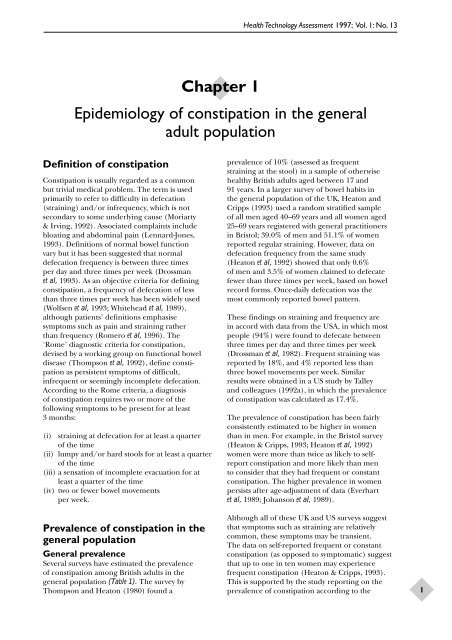Effectiveness of Laxatives in the Elderly - NIHR Health Technology ...
Effectiveness of Laxatives in the Elderly - NIHR Health Technology ...
Effectiveness of Laxatives in the Elderly - NIHR Health Technology ...
You also want an ePaper? Increase the reach of your titles
YUMPU automatically turns print PDFs into web optimized ePapers that Google loves.
Def<strong>in</strong>ition <strong>of</strong> constipation<br />
Constipation is usually regarded as a common<br />
but trivial medical problem. The term is used<br />
primarily to refer to difficulty <strong>in</strong> defecation<br />
(stra<strong>in</strong><strong>in</strong>g) and/or <strong>in</strong>frequency, which is not<br />
secondary to some underly<strong>in</strong>g cause (Moriarty<br />
& Irv<strong>in</strong>g, 1992). Associated compla<strong>in</strong>ts <strong>in</strong>clude<br />
bloat<strong>in</strong>g and abdom<strong>in</strong>al pa<strong>in</strong> (Lennard-Jones,<br />
1993). Def<strong>in</strong>itions <strong>of</strong> normal bowel function<br />
vary but it has been suggested that normal<br />
defecation frequency is between three times<br />
per day and three times per week (Drossman<br />
et al, 1993). As an objective criteria for def<strong>in</strong><strong>in</strong>g<br />
constipation, a frequency <strong>of</strong> defecation <strong>of</strong> less<br />
than three times per week has been widely used<br />
(Wolfsen et al, 1993; Whitehead et al, 1989),<br />
although patients’ def<strong>in</strong>itions emphasise<br />
symptoms such as pa<strong>in</strong> and stra<strong>in</strong><strong>in</strong>g ra<strong>the</strong>r<br />
than frequency (Romero et al, 1996). The<br />
‘Rome’ diagnostic criteria for constipation,<br />
devised by a work<strong>in</strong>g group on functional bowel<br />
disease (Thompson et al, 1992), def<strong>in</strong>e constipation<br />
as persistent symptoms <strong>of</strong> difficult,<br />
<strong>in</strong>frequent or seem<strong>in</strong>gly <strong>in</strong>complete defecation.<br />
Accord<strong>in</strong>g to <strong>the</strong> Rome criteria, a diagnosis<br />
<strong>of</strong> constipation requires two or more <strong>of</strong> <strong>the</strong><br />
follow<strong>in</strong>g symptoms to be present for at least<br />
3 months:<br />
(i) stra<strong>in</strong><strong>in</strong>g at defecation for at least a quarter<br />
<strong>of</strong> <strong>the</strong> time<br />
(ii) lumpy and/or hard stools for at least a quarter<br />
<strong>of</strong> <strong>the</strong> time<br />
(iii) a sensation <strong>of</strong> <strong>in</strong>complete evacuation for at<br />
least a quarter <strong>of</strong> <strong>the</strong> time<br />
(iv) two or fewer bowel movements<br />
per week.<br />
Prevalence <strong>of</strong> constipation <strong>in</strong> <strong>the</strong><br />
general population<br />
General prevalence<br />
Several surveys have estimated <strong>the</strong> prevalence<br />
<strong>of</strong> constipation among British adults <strong>in</strong> <strong>the</strong><br />
general population (Table 1). The survey by<br />
Thompson and Heaton (1980) found a<br />
Chapter 1<br />
<strong>Health</strong> <strong>Technology</strong> Assessment 1997; Vol. 1: No. 13<br />
Epidemiology <strong>of</strong> constipation <strong>in</strong> <strong>the</strong> general<br />
adult population<br />
prevalence <strong>of</strong> 10% (assessed as frequent<br />
stra<strong>in</strong><strong>in</strong>g at <strong>the</strong> stool) <strong>in</strong> a sample <strong>of</strong> o<strong>the</strong>rwise<br />
healthy British adults aged between 17 and<br />
91 years. In a larger survey <strong>of</strong> bowel habits <strong>in</strong><br />
<strong>the</strong> general population <strong>of</strong> <strong>the</strong> UK, Heaton and<br />
Cripps (1993) used a random stratified sample<br />
<strong>of</strong> all men aged 40–69 years and all women aged<br />
25–69 years registered with general practitioners<br />
<strong>in</strong> Bristol; 39.0% <strong>of</strong> men and 51.1% <strong>of</strong> women<br />
reported regular stra<strong>in</strong><strong>in</strong>g. However, data on<br />
defecation frequency from <strong>the</strong> same study<br />
(Heaton et al, 1992) showed that only 0.6%<br />
<strong>of</strong> men and 3.5% <strong>of</strong> women claimed to defecate<br />
fewer than three times per week, based on bowel<br />
record forms. Once-daily defecation was <strong>the</strong><br />
most commonly reported bowel pattern.<br />
These f<strong>in</strong>d<strong>in</strong>gs on stra<strong>in</strong><strong>in</strong>g and frequency are<br />
<strong>in</strong> accord with data from <strong>the</strong> USA, <strong>in</strong> which most<br />
people (94%) were found to defecate between<br />
three times per day and three times per week<br />
(Drossman et al, 1982). Frequent stra<strong>in</strong><strong>in</strong>g was<br />
reported by 18%, and 4% reported less than<br />
three bowel movements per week. Similar<br />
results were obta<strong>in</strong>ed <strong>in</strong> a US study by Talley<br />
and colleagues (1992a), <strong>in</strong> which <strong>the</strong> prevalence<br />
<strong>of</strong> constipation was calculated as 17.4%.<br />
The prevalence <strong>of</strong> constipation has been fairly<br />
consistently estimated to be higher <strong>in</strong> women<br />
than <strong>in</strong> men. For example, <strong>in</strong> <strong>the</strong> Bristol survey<br />
(Heaton & Cripps, 1993; Heaton et al, 1992)<br />
women were more than twice as likely to selfreport<br />
constipation and more likely than men<br />
to consider that <strong>the</strong>y had frequent or constant<br />
constipation. The higher prevalence <strong>in</strong> women<br />
persists after age-adjustment <strong>of</strong> data (Everhart<br />
et al, 1989; Johanson et al, 1989).<br />
Although all <strong>of</strong> <strong>the</strong>se UK and US surveys suggest<br />
that symptoms such as stra<strong>in</strong><strong>in</strong>g are relatively<br />
common, <strong>the</strong>se symptoms may be transient.<br />
The data on self-reported frequent or constant<br />
constipation (as opposed to symptomatic) suggest<br />
that up to one <strong>in</strong> ten women may experience<br />
frequent constipation (Heaton & Cripps, 1993).<br />
This is supported by <strong>the</strong> study report<strong>in</strong>g on <strong>the</strong><br />
prevalence <strong>of</strong> constipation accord<strong>in</strong>g to <strong>the</strong><br />
1
















